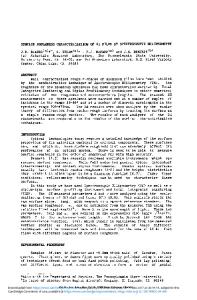Characterization of Thin Organic and Polymeric Films by Spectroscopic Methods
- PDF / 337,936 Bytes
- 3 Pages / 604.8 x 806.4 pts Page_size
- 26 Downloads / 362 Views
change due to different surface treatments of the same substrate. The exact nature of these changes is the object of numerous characterization studies which will be discussed in a later section. In addition to the order and orientation of m o l e c u l a r s e g m e n t s w h i c h can be caused by t h e s u b s t r a t e , a d d i t i o n a l a n i s o t r o p y in a d e p o s i t e d film can be induced by the processing procedure. 2 Radial orientation can be introduced by spinning, while "doctor blading" (running a sharp blade across a drop of viscous solution in order to spread it on a substrate) can give rise to uniaxial orientation in thin film.3 Still other methods can be employed to deposit oriented films on solid substrates. Figure 1 illustrates the preparation of Langmuir-Blodgett (LB) films from a monolayer of amphiphilic molecules (those containing a hydrophobic a n d a hydrophilic part) which are first deposited on a water surface, then compressed to form an ordered structure. 4 The monolayer can then be transferred to a solid substrate either with the head group (hydrophilic substrate) or the alkyl tail (hydrophobic substrate) in contact with the surface. Multilayered films can be constructed by multiple insertions and withdrawals of the substrate through the film. An a l t e r n a t i v e p r o c e s s , w h i c h h a s gained r e n e w e d popularity d u e to the work of Sagiv, 5 is illustrated in the lower portion of Figure 1 and has become known as Self-Assembly (SA). In this approach, the substrate is submerged in a dilute solution of a m p h i p h i l i c m o l e c u l e s for a n extended period (1-2 hours) during which molecules migrate to the substrate surface and physisorb to it. Recent contact angle measurements on both LB and SA films of arachidic acid suggest that both films are structurally similar. Much work has been done to investigate these thin layers by optical methods. The following discussion of several of these characterization techniques indicates their current and future potential for studying thin films.
Experimental Methods Refractive Index Measurements One of the more straightforward methods of determining structural anisotropy in thin films is through measurement of the
Monolayer Assemblies
Langmuir-Blodgett films
mm?
ttfillllll
H20
Compress molecules on water surface, withdraw sample to transfer film. Self-assembled films
Spontaneous film formation from solution.
Figure 1. Schematic of film preparation by Langmuir-Blodgett deposition and Self-Assembly (SA). in- and out-of-plane refractive indices. 3 In the visible region of the spectrum, this can be accomplished by depositing the film whose optical constants are desired onto a substrate of lower refractive index as illustrated in Figure 2. High index glass prisms can then be used to couple a laser into the thin film as shown. This asymmetric slab waveguide can then be probed by polarized light, the discrete coupling angle, , being a very sensitive function of the optical constants of the film. If the electric fiel
Data Loading...








